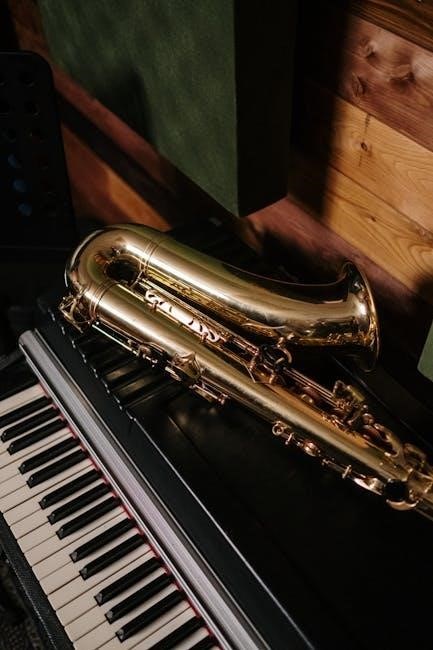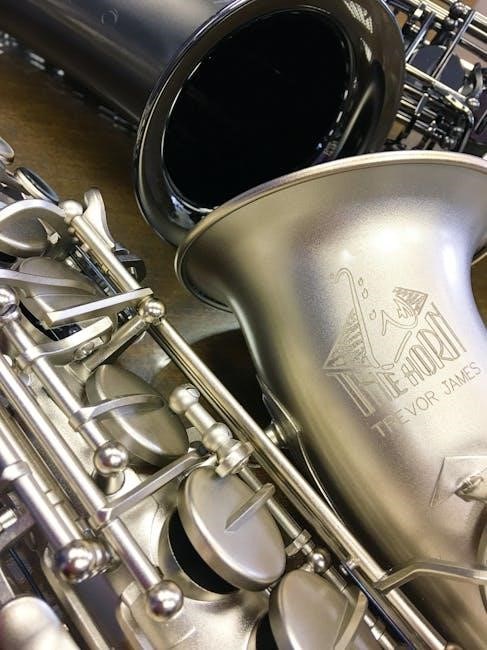Welcome to this comprehensive guide on saxophone mouthpieces! Discover how to choose, maintain, and optimize your mouthpiece for improved sound and performance across various genres and skill levels.
1.1 Importance of the Mouthpiece in Saxophone Performance
The mouthpiece is crucial for saxophone performance, directly influencing tone quality, intonation, and playability. Its design and dimensions affect airflow and reed vibration, shaping the sound produced. A well-suited mouthpiece enhances comfort and control, allowing players to express their musicality effectively across genres and skill levels. Small variations can significantly impact performance, making it vital for players to find the right fit.
1.2 Brief Overview of the Guide
This guide provides an in-depth exploration of saxophone mouthpieces, covering their components, materials, and selection criteria. It addresses the needs of players at all levels, from beginners to professionals, offering insights into maintenance, troubleshooting, and optimization. Whether you’re seeking improved tone, better playability, or a customized fit, this guide will help you make informed decisions and enhance your saxophone performance.
Types of Saxophones and Their Mouthpiece Requirements
Alto, tenor, baritone, and soprano saxophones each require specific mouthpiece designs tailored to their unique sound and playability needs, ensuring optimal performance across genres and player levels.
2.1 Alto Saxophone Mouthpieces
Alto saxophone mouthpieces are designed to balance tone, intonation, and playability. They typically feature medium tip openings and chambers, catering to both beginners and professionals. Materials vary from hard rubber to metal, each offering distinct tonal characteristics. Proper reed strength and facing length ensure optimal performance, making alto mouthpieces versatile for jazz, classical, and other genres.
2.2 Tenor Saxophone Mouthpieces
Tenor saxophone mouthpieces are crafted for rich, full-bodied sound, often with larger tip openings and chambers. They suit various playing styles, from smooth jazz to powerful solos. Materials range from hard rubber to metal, each offering unique tonal nuances. Properly matched with reeds and facings, tenor mouthpieces enhance projection and articulation, making them a staple in both professional and intermediate settings.
2.3 Baritone and Soprano Saxophone Mouthpieces
Baritone and soprano saxophone mouthpieces cater to specific tonal needs. Baritone mouthpieces often feature larger chambers for deeper tones, while soprano mouthpieces are more compact, emphasizing clarity and agility. Both types require precise reed and facing matches to ensure optimal playability and sound quality, making them ideal for versatile musicians exploring diverse musical genres and styles effectively.

Key Components of a Saxophone Mouthpiece
The saxophone mouthpiece consists of the tip opening, chamber, baffle, and facing length. These elements collectively influence tone, intonation, and responsiveness, shaping the instrument’s sound and playability.
3.1 Tip Opening and Its Impact on Sound
The tip opening, the distance the reed vibrates, significantly affects the saxophone’s sound. A smaller opening produces a brighter, more focused tone, while a larger opening yields a warmer, richer sound. Proper sizing is crucial for optimal performance and player comfort, influencing both pitch accuracy and dynamic range effectively in various musical settings and styles.
3.2 Chamber Size and Shape
The chamber’s size and shape significantly influence the saxophone’s tone and resonance. A larger chamber often produces a warmer, richer sound, while a smaller chamber yields brighter, more focused tones. The design affects airflow and harmonic balance, making certain chamber configurations better suited for specific genres, from classical to jazz, and tailored to individual player preferences for optimal musical expression and clarity.
3.3 Baffle and Its Role in Tone Production
The baffle, a key component inside the mouthpiece, plays a crucial role in tone production by directing airflow and influencing the reed’s vibration. A high baffle creates a brighter, more aggressive sound, while a low baffle produces a smoother, darker tone. This feature is essential for achieving the desired timbre and response, making it a focal point for saxophonists seeking specific tonal qualities and playing styles.
3.4 Facing Length and Its Effects
The facing length, measuring the distance from the tip to where the reed attaches, significantly impacts playability and tone. A shorter facing length offers easier response and brighter sound, while a longer one provides deeper tones and more control. Proper alignment with the reed is crucial for optimal performance, ensuring clarity and intonation across the saxophone’s range, catering to different musical styles and player preferences effectively.

Materials and Finishes for Saxophone Mouthpieces
Saxophone mouthpieces are crafted from materials like metal, hard rubber, plastic, or resin, each offering distinct tonal qualities. Finishes such as gold, silver, or titanium plating enhance durability and aesthetics, optimizing performance and personal preference.
4.1 Metal vs. Hard Rubber Mouthpieces
Metal mouthpieces offer bright tones and durability, ideal for jazz, while hard rubber provides warmth and comfort, often preferred in classical settings. Each material caters to different player preferences and musical genres, ensuring optimal performance and sound quality.
4.2 Plastic and Resin Mouthpieces
Plastic and resin mouthpieces are durable, lightweight, and cost-effective, making them ideal for beginners. They resist wear and tear, offering consistent performance. Resin mouthpieces often mimic the tone of hard rubber, while plastic provides a bright, focused sound, suitable for students and casual players seeking affordability without compromising playability and tone quality.
4.3 The Role of Plating and Coatings
Plating and coatings enhance durability and aesthetics of saxophone mouthpieces. Metals like gold, silver, and nickel are commonly used to protect against corrosion and improve longevity. Some coatings offer a smoother feel, while others may subtly affect tone. Proper maintenance is crucial to preserve these finishes and ensure optimal performance and appearance over time.
Choosing the Right Mouthpiece for Your Needs
Selecting the ideal mouthpiece involves trials, evaluating comfort, tone, and responsiveness. Consider your skill level, musical genre, and personal preferences to find the perfect fit for optimal performance.
5.1 Beginner-Friendly Mouthpieces
Beginners benefit from mouthpieces with medium tip openings and softer materials like hard rubber or plastic. These options provide ease of play, consistent intonation, and reduced fatigue, making them ideal for developing proper embouchure and technique. Affordable and durable, they offer a great starting point for new saxophonists to build confidence and skills effectively.
5.2 Intermediate and Professional Mouthpieces
Intermediate and professional saxophonists often prefer mouthpieces with specific tip openings and materials tailored to their style. Metal mouthpieces offer brightness and clarity, while hard rubber provides warmth. Custom options allow precise adjustment for optimal tone and response, catering to advanced players seeking nuanced sound and performance in demanding musical settings and genres like jazz or classical.
5.3 Mouthpiece Selection Based on Musical Genre
Choosing the right mouthpiece depends on the musical genre. Jazz players often prefer brighter, responsive metal mouthpieces with medium to large tip openings. Classical musicians may opt for hard rubber pieces with smaller tip openings for a warmer, more controlled tone. Rock and pop saxophonists might favor balanced, versatile designs that offer clarity and projection across dynamic ranges and styles.
Maintenance and Care of Saxophone Mouthpieces
Regularly clean and sanitize your mouthpiece to remove bacteria and old reed residue. Use a mouthpiece brush with mild soap and rinse thoroughly. Avoid soaking in harsh chemicals or extreme temperatures to prevent damage. Store in a protective case to prevent scratches and chips, ensuring it remains in optimal condition for consistent performance.
6.1 Cleaning and Sanitizing
Use a soft-bristled mouthpiece brush with mild soap and warm water to remove bacteria, old reed residue, and debris. Rinse thoroughly and dry with a clean cloth. Avoid harsh chemicals or abrasive materials that could damage the mouthpiece. Regular cleaning ensures hygiene and maintains optimal sound quality. Sanitize periodically with a solution of equal parts water and white vinegar for deeper maintenance.
6.2 Proper Storage and Handling
Store your mouthpiece in a protective case to prevent scratches and damage. Avoid exposing it to extreme temperatures or humidity. Handle the mouthpiece gently, ensuring it is clean before storage. Place it in a position where it won’t be bent or compressed. Regularly inspect for wear and tear, and avoid exposing it to harsh chemicals or abrasive materials that could compromise its finish or integrity.
6.3 Avoiding Damage and Wear
Proper care is essential to extend the life of your saxophone mouthpiece. Avoid dropping it, as impacts can cause cracks or misalignment. Clean it regularly with a soft brush and mild soap, avoiding harsh chemicals that might damage the material; After cleaning, ensure it’s completely dry before storing to prevent moisture buildup. Store it in a protective case away from extreme temperatures and direct sunlight. Regularly inspect for signs of wear, such as scratches or dents, and address them promptly to prevent further damage. By following these steps, you can maintain the quality and performance of your mouthpiece.
The Process of Trying Out Mouthpieces
Trying out mouthpieces involves evaluating comfort, tone, and response. Assess playability and overall performance to find the best fit for your saxophone playing needs.
7.1 What to Expect in a Mouthpiece Trial
A mouthpiece trial involves testing different models to assess comfort, tone, and playability. Expect to evaluate how the mouthpiece feels and performs during practice. Play familiar pieces to gauge response and intonation. Consider using a metronome to check articulation and accuracy. This process helps identify the best fit for your playing style and musical goals.
7.2 Evaluating Comfort and Playability
Assess how the mouthpiece feels physically and how easily you can produce notes. Pay attention to embouchure comfort and breath control. Check if the mouthpiece causes fatigue or strain during extended play. Evaluate its responsiveness across dynamics and articulations. A well-fitting mouthpiece should feel natural, allowing you to focus on your music without discomfort or technical hindrance.
7.3 Assessing Tone and Response
Listen for clarity, richness, and consistency in the tone. Test the mouthpiece across different registers and dynamics. Ensure it responds evenly, with good intonation and articulation. A quality mouthpiece should project your sound effectively, offering the desired brightness or warmth. Play with a comfortable embouchure and reed setup to accurately gauge its performance and suitability for your playing style and musical genre.

Stock vs. Custom Mouthpieces
Stock mouthpieces are mass-produced, offering consistent quality and affordability for most players. Custom mouthpieces are tailored to individual needs, providing enhanced performance and personalized fit at a higher cost.
8.1 Advantages of Stock Mouthpieces
Stock mouthpieces are cost-effective, widely available, and designed for general playability. They suit beginners and professionals alike, offering consistent quality and reliability. Easy to find in stores or online, they often come with warranties and manufacturer support, making them a practical choice for most saxophonists.
8.2 Benefits of Custom-Made Mouthpieces
Custom-made mouthpieces offer tailored fit and tone, enhancing individual playing styles. Crafted to precise specifications, they optimize sound quality, intonation, and comfort. Players with unique preferences or specific needs benefit most, as these mouthpieces are designed to maximize their potential and provide a personalized saxophone experience.
8.3 Cost Considerations
Stock mouthpieces are generally more affordable, making them accessible to beginners and students. Custom-made options, while offering superior fit and sound, are significantly more expensive due to the craftsmanship involved. Balancing budget with performance needs is crucial when deciding between stock and custom mouthpieces for saxophonists of all levels.
Common Issues and Troubleshooting
Addressing intonation problems, reed compatibility, and airflow issues are common challenges saxophonists face. Proper mouthpiece adjustment and maintenance are key to resolving these issues for optimal sound quality.
9.1 Intonation Problems
Intonation issues can arise from improper mouthpiece fit, reed strength, or facing length. Adjusting the mouthpiece position and experimenting with different reeds may resolve pitch inconsistencies. Regular maintenance and professional adjustments ensure accurate intonation across the saxophone’s range for consistent sound quality and performance.
9.2 Reed Compatibility and Adjustment
Reed compatibility is crucial for optimal performance. Ensure the reed strength matches your mouthpiece and playing style. Soaking reeds before use enhances responsiveness. Adjusting the ligature and mouthpiece position can improve tone. Experiment with different reed brands and strengths to find the perfect balance for your saxophone setup and musical genre requirements.
9.3 Airflow and Embouchure Issues
Airflow and embouchure issues can significantly affect sound quality. Ensure a firm yet relaxed embouchure with proper lip and jaw alignment. Adjusting breath control and air support helps maintain consistent tone. Regular practice and adjustments to mouthpiece position can resolve common airflow problems, enhancing overall saxophone performance and comfort during play.
This guide has covered essential aspects of saxophone mouthpieces, from selection to maintenance. Experiment with different options to find your perfect fit and elevate your performance.
10.1 Summary of Key Points
10.2 Encouragement to Experiment and Find the Right Fit
Don’t hesitate to explore different mouthpieces to discover what suits your style and preferences. Each player is unique, and the right fit can elevate your performance significantly. Take your time to test various options, as patience often leads to the perfect match for your sound and comfort. Remember, experimentation is key to unlocking your full potential as a saxophonist.

Resources for Further Learning
Explore recommended books, videos, and online forums to deepen your understanding of saxophone mouthpieces. Visit manufacturer websites and join saxophonist communities for expert advice and shared experiences.
11.1 Recommended Reading and Videos
Check out Theo Wanne’s detailed guides and videos on mouthpiece selection and care. Explore manufacturer websites like Vandoren and D’Addario for insightful resources. Subscribe to educational channels on YouTube for demonstrations and expert advice. Additionally, KQED’s MindShift article offers tips on refining your search for quality saxophone content. These resources provide a wealth of knowledge to enhance your understanding and skills.
11.2 Online Communities and Forums
Join forums like Sax on the Web and Woodwind Forum to engage with saxophonists worldwide. These platforms offer valuable discussions on mouthpiece trials, maintenance, and recommendations. Share experiences, ask questions, and gain insights from seasoned players. Participating in these communities can help you find the perfect mouthpiece and refine your saxophone skills through shared knowledge and expertise.
11.3 Professional Advice and Workshops
Consult professional saxophonists and technicians for personalized mouthpiece recommendations. Attend workshops to gain hands-on experience with different setups. Many clinics offer sessions on optimizing your mouthpiece for tone and playability. These resources provide tailored guidance, helping you refine your sound and technique effectively. Workshops often cover topics like tip openings, facing lengths, and equipment selection, catering to both intermediate and professional players.
